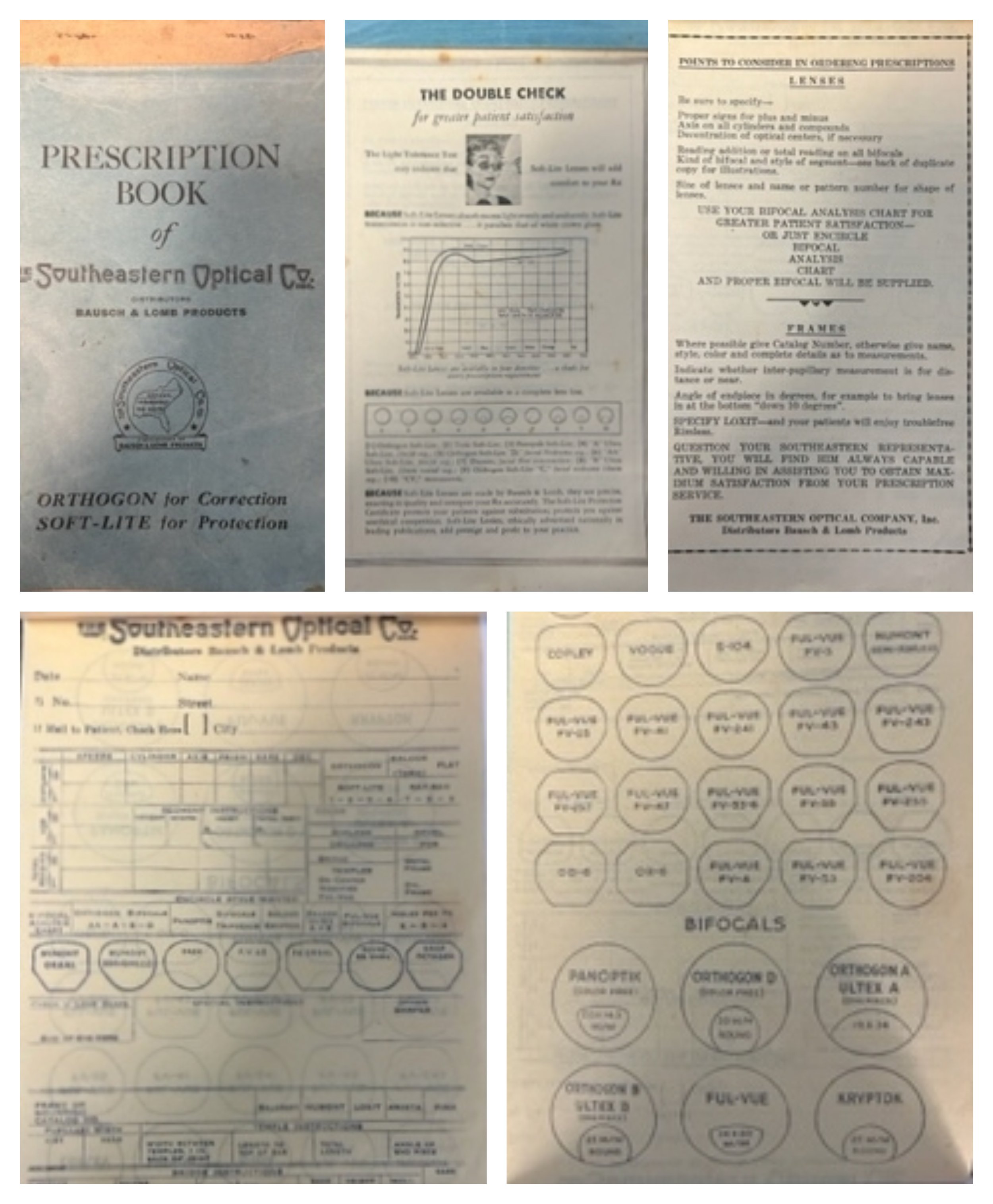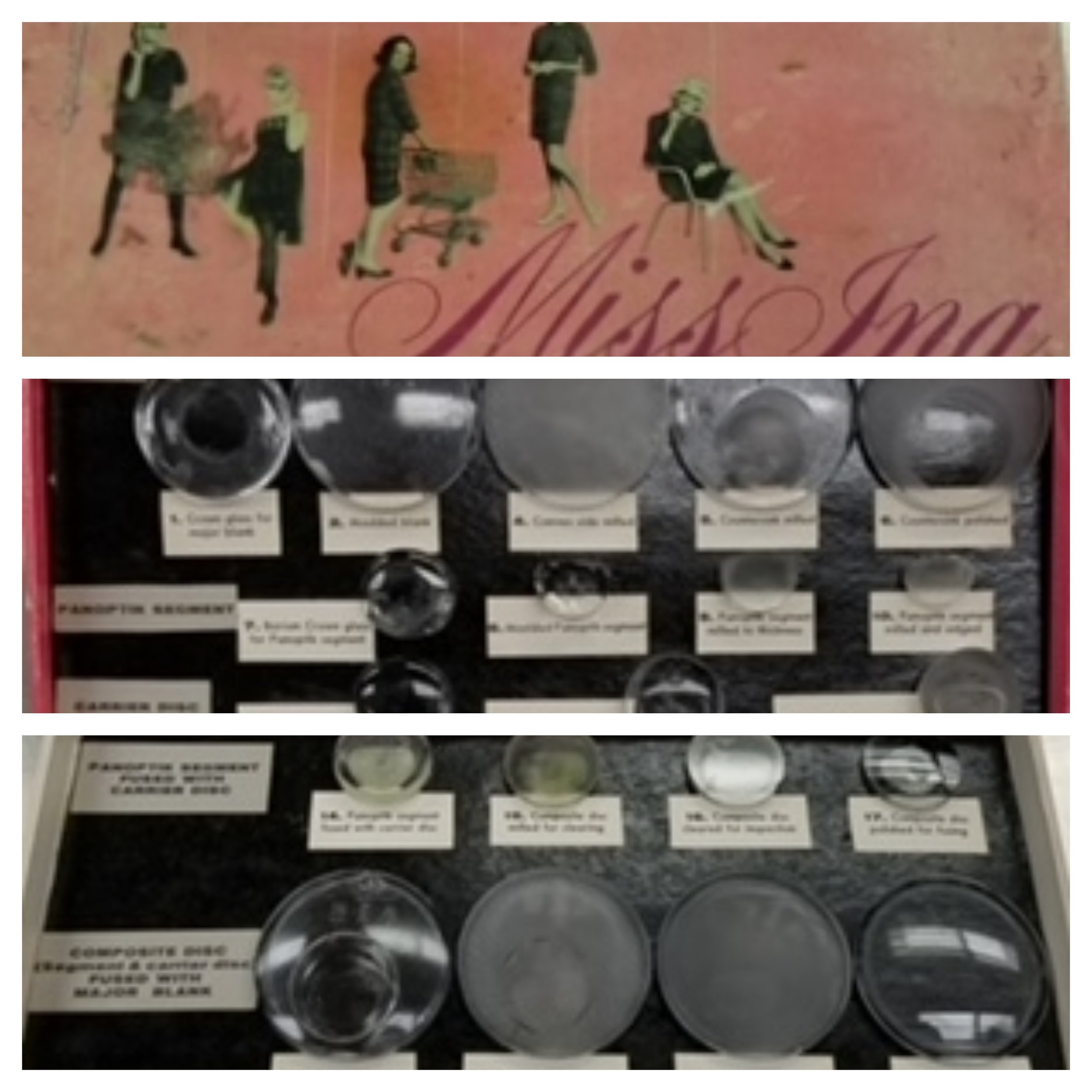The Mindy Pollock Collection
Mindy has been in the optical industry for over 30 years and during that time she has created a collection of optical equipment, books, and oddities. Here are some that she has graciously shared with Optigal Consulting over the years.

Advertisement by Bausch and Lomb Title: Hermann Von Helmholtz with his ophthalmoscope Date: 1936 Artist: Harold Anderson Size: 15"x20" Hermann Von Helmholtz with his ophthalmoscope, (invented 1851) saw the interior of a living eye and founded the science of precise eye examination.

Prescription Book for the Southeastern Optical Company Southeastern Optical Company was based in Richmond, VA, and incorporated on April 20, 1937. They had offices all across the southern United States for a minimum of 10 years and were a main distributor in the area for Bausch and Lomb. Page 1 - Advises the administration of a light tolerance test that may indicate the need for B and L's Soft-Lite light absorptive lenses. Page 2 - A checklist to ensure that the order forms are properly filled out for greater patient satisfaction and to speed production. Page 3 - Order form with detailed manufacturing guidelines. Page 4 - Lens shapes and Bifocal types available at the company's facilities.

Bausch and Lomb Panoptik Construction Set Panoptik was developed by Bausch and Lomb after the success of the first straight top bifocal by the Univis Lens Company of Dayton, OH. This sales tool kit, probably from the 1950s - 1960s, was an important tool for the time. It was common at the time for a prescriber or optician to specify a "trade name" to the lens distributor or manufacturer for lined bifocals. By using a kit like this, showing the steps in the lens manufacturing process, the sales rep was more likely to have his brand specified.

Business Card from Dr. Harold Cline's Office and Lavoptik Eye Wash Dr. Cline graduated from the US Naval Academy and then from the Illinois College of Optometry in 1924. He was still practicing in 1956, when the business card with calendar was most likely distributed to one of his patients based on the design and print. The Lavoptik Eye Wash is in a tiny 3 inch tall clear-glass rectangular-shaped antique 'SAMPLE EYE WASH' bottle. This is an ORIGINAL ANTIQUE blown glass bottle with a cork top, dating over 100 years old. Bottle's label reads, in part: "SAMPLE / LAVOPTIK / (picture of eye) / EYE WASH .. Lavoptik Company St. Paul, Minnesota, U.S.A."

Prescription and Original Lenses from May 15, 1907. Prescription and original lenses from a patient seen at the Chase and Sanford Company in Boston, Mass. Chase and Sanford was a seller of ophthalmic and photographic goods. In 1909, the owner, Waltham, sold the company to R.N. Wallingford who worked for Waltham at his other business, a watch factory. I cannot find mention of the company after April, 1909. Alexander Quackenboss, MD, the prescriber, graduated from Dartmouth in 1887. Prior to 1906, he was the Auxiliary Ophthalmologist for the Boston Floating Hospital.

Gowlland May Ophthalmoscope circa 1910-1920 Gowllands Limited was established at the end of the nineteenth century by three Gowlland brothers. Initially they were specialized in ophthalmological instruments, then in diagnostic instruments for ear, eye, nose and throat. The firm exists still today and it produces and exports diagnostic instruments to more than 140 different countries worldwide. The ophthalmoscope is in its original wooden box that is silk-lined and is signed Gowllands, Made in England

Nu-Way Optical Company Mail Order Spectacle Kit form the 1930s, 1940s era. Nu-Way Optical Company believed that eyeglass powers were subjective and had the end consumer determine their needed power in the privacy of their home. They had operations in Canada and the United States that processed orders from individuals as well as from a traveling sales team. This particular kit was a disposable mail kit that allowed the consumer to decide the power needed by clarity of the card placed on the slider of the stick. As the slide moved up and clarity was achieved, it would correspond to a power on the mail-in slip. The spectacles were then mailed to the consumer with a satisfaction guarantee. This particular set also included an advertisement to become a sales representative for the company with a $10 investment.

Dr. Isaac Thompson's Eye Water Dr. Isaac Thompson's Celebrated Eye Water Trade Card (Back) From: Dr. Isaac Thompson's Celebrated Eye Water Trade Card Original caption: Dr. Isaac Thompson’s Celebrated Eye Water, for all complaints of the eyes. Each bottle is stamped with my proprietary stamp. None other genuine. The Genuine Eye Water Is enfolded in an engraved envelope, on which is the likeness of the original inventor, Dr. Isaac Thompson, New London, Conn., with a fac-simile of his signature; also the signature of John L. Thompson, with a note of hand, signed by John L. Thompson, 161 River Street, Troy, N.Y. None other can be genuine. This well-known and thoroughly efficient remedy has acquired a worldwide reputation, having been before the public for over eighty-five years, and it is a remarkable fact that it’s reputation has been sustained simply by the merits of the medicine, as the many thousands, who have used it, will bear testimony. Its merits stand unrivaled. In constant use since 1795. Price…………25 Cents per bottle John L. Thompson, Proprietor, Troy, N.Y. Creator: n/a Date: Circa 1885 According to the DEA, "Dr. Isaac Thompson’s Celebrated Eye Water was produced in the U.S. from 1795 until the late 1950s. Its creator was a druggist from Connecticut who developed the product to treat common eye ailments. For more than one-hundred years, consumers were unaware that each bottle contained opium, a highly addictive drug. To advertise the Eye Water and other remedies, patent medicine companies distributed attractive, collectible trade cards."

P - D Gauge by Bausch and Lomb A pupillometer from Bausch & Lomb located in the United States. From the mid-1960s, the measurements are P-D Gauge: 31 x 232 x 138 mm; box: 39 x 242 x 149 mm. The tool has a white (upper) and brown plastic (lower side). Black plastic adjustment wheel. In original lidded cardboard box printed in red and black. Fourth printing instruction leaflet.

Miss Ina Box and Lens Assembly Kit I believe that this kit was put together by a sales rep in the mid to late 1960s from a frame display box. Miss Ina is the German model, Ina Balke, who not only was B&L's top model in the early 1960s, but was also the 'Miss Beauty in Glasses, 1963'. The frame Ina was released in 1964 and is part of the Miss Ina frame collection. The lens kit was probably created to get the prescriber to specify a brand name. It was common at the time for a prescriber or optician to specify a "trade name" to the lens distributor or manufacturer for lined bifocals. By using a kit like this, showing the steps in the lens manufacturing process, the sales rep was more likely to have his brand specified.

Vintage Cased Essilor Tube Pupilometer Hand Held Pupillometer from the late 1960s. A cased binocular pupillometer of two parallel cream colored metal tubes. Positive lenses in user's eyepieces. Plastic rims at patient's end have a space to allow insertion of supplementary lenses. Millimeter scale allows monocular pupillary distances to be read. Black metal occluder at user's end sprung to occlude each eye alternately. Boxed in grey covered cardboard slip case. 4 supplementary lenses (2 x +3D, 2 x -3D). May also be called an Essel pupilometer because the pupilometer is designed in the same format as one by that company.

Shuron 82-A All-Shape Lens Cutter Serial #7513. This is a green enameled, metal lens cutter that is about 270 mm high. There is a spindle for attaching a pattern underneath, a scaled wheel for adjusting lens size on left hand side, and a lever on right side to bring the pattern guide arm to bear on the pattern. The round turntable has a red rubber cushion for the lens, a handle for bringing the lens clamp and cutter blade down on to lens, and a second lever on the right side for locking the lens clamp. Finally, a handle for rotating the turntable so that the lens can be edged to size. This model of lens cutter was patented in April 1935 although the patent papers were filed in August 1932. The patent is in the name of W A Lockhart assignor to Shuron Optical Company.